-

人教版高中英语必修4Theme parks说课稿3篇
The oldest and the most popular park in the worldenjoy the exciting activities thereget close to the life-size cartoon characters like Mickey Mouse and Donald Duck Step 3 Pre-reading1.What do you suppose a theme park is ?2.What do you think you can see in a theme park?(1.It is a kind of amusement park which has a certain theme – that the whole park is based on. 2.buildings, castles, statues, rare animals and birds, and so on.) Step 4 Reading ----- Theme Parks –---- Fun and More Than Fun1.Predict : Read the title and the pictures on P. 34 and PredictWhat is the meaning of the title “Theme Park – Fun and more than fun”?(The title means that theme parks are fun to visit, but that they can also be educational and can offer useful information.)2.Skimming Fast read and answer:What activities can we take in a theme park?Amusement park: Bumper car Merry-go-round slide bungee jumping Free-fall rides Horror films Pirate ship Ferris wheel roller coaster3.Scanning Read again and you will find various theme parks are mentioned in the passage . Then what are they ?Theme parks: Sports theme park History theme park Culture theme park Marine or Ocean theme Park Future park Science theme park Disneyland4.Careful reading and find the main idea of each paragraph:THEME PARKS---- entertaining/ educationalPara.1 Traditional parks are places to go for relaxation and to have time away from our busy lives.Para.2 Theme parks are different They’re large and full of things to do, see and buy.Para.3 Theme parks are built around a single idea or theme. One example is a sports park.Para.4 Another kind of theme park is historical more and cultural and can be educational.Para.5 Disneylandwas the first theme park. It is based on the fantasy life and characters of Disney’s films.Para.6 Some examples of educational theme parks include sea world parks and science parks.

人教版高中英语必修3Healthy Eating说课稿4篇
Language learning needs a context, which can help the learners to understand the language and then can product comprehensible output, so computer has the advantages to make the materials attractive.Part 3 Learning MethodsTask-based, self-dependent and cooperative learningPart 4 Teaching ProcedureStep One Lead-in“Interest is the best teacher.” Therefore, at the very beginning of the class, I should spark the students’ mind to focus on the centre topic “the band”. I’ll show some pictures of food to attract their attention and then bring some questions.Question:What kind of food they like?What should go into a good meal?The answers must relate to the diet. After this, the students will be eager to know something about a balance diet and this is the very time to naturally lead the class into Step 2Step 2 Reading for information: skimming and scanning In this step, I use Task-based Language Teaching method, which can give students a clear and specific purpose while skimming and scanning the context.Task 1 General ideaThe students will be asked to just glance at the title and the pictures of the passage, and then guess what they will read in the text. And they’ll be divided into groups of four to have a discussion.The purpose is to inspire the students to read actively, not passively. In addition, the task is to develop the students’ reading skill by making prediction and to encourage the students to express their thoughts in English and cooperate with each other.Task 2 Main idea of each paragraphCooperative learning can raise the students’ interest and create an atmosphere of achievement. Based on this theory, I divide the whole class into 4 groups to skim the whole text and get the main idea of each paragraph.

人教版高中英语必修3The million pound bank note说课稿3篇
在接下来的细读环节,我套用了高考对阅读理解的考查方式设置了5个问题,分别为三个推理判断题,一个细节题和一个主旨大意题。学生需要对文章的内容进行分析、归纳、推理、猜测等高级思维活动才能做出正确的回答。【设计意图】这一过程是对学生进行细读的训练,培养学生获取特定信息和挖掘文章深层次信息的能力。第三环节:Intensive-reading (精读) 15′第三个环节精读,既是最重要的环节,也是突破本课重难点的关键。首先,让学生思考剧本中人物看到百万英镑前后的态度发生了怎样的变化。其次,让学生仔细阅读文章,找出可以表现人物态度变化的具体的语言和动作。最后,让学生总结人物的态度发生变化的根本原因是什么,从而引出Money Talks, 供学生思考。【设计意图】通过一系列的活动培养学生学习从人物的语言和动作探究人物的心理,使学生进一步体会戏剧语言的魅力,从而对文章背后所反映的社会问题进行思考,也为下一步的讨论环节做好铺垫。

人教版高中英语必修5First aid说课稿6篇
In this class, I have 3 teaching aims, that is, knowledge aims, ability aims and emotion aims.1) Knowledge-Teach students new words and expressions, such as temporary, bleed,sprain choke, first aid, fall ill and so on.-Enable students to have a better understanding for some basic knowledge of first aid.2) Ability-Train students’ speaking, reading and writing abilities by different teaching activities, such as skimming, comprehending, team work, role play, retelling and writing.-Develop students’ reading strategy on how to move general idea to specific information.3) Emotion-Promote students’ awareness of giving first aid.- Cultivate students’ creativities.Then let’s come to my teaching methods and activities.III. Teaching methods and activities:To achieve different teaching aims, various kinds of teaching methods and activities will be adopted throughout this period, such as TBL (task-based learning), skimming, team work, brainstorm and others, which can offer students opportunities to fulfill tasks in which they can use language to achieve a specific outcome.IV. Teaching aids:Computer and blackboardV. Teaching important points:1) Make students have a clear mind for the structure of the text.2) Help students understand the theme of the text.VI. Teaching difficulties:1) So many new words may affect students’ understanding.2) How to get students to know about the functions of the skin and thecauses, characteristics and treatments for different degree burns,and the knowledge about giving first aid. VII. Blackboard design:

人教版高中英语必修5Great scientists说课稿4篇
通过写文章梗概,培养学生综合运用语言的能力,学习用恰当的英语描述科学家的故事。这是本课的教学难点。教师可以使用完形填空的方式来帮助学生整理语篇,从而来降低难度。本课的教学重点的突破方法是:在阅读前,让学生初步了解得出科学观点所需要的基本程序,从而轻松而自然地导入文章的阅读;在阅读过程中,由易到难设计快速阅读和精读的问题,层层推进各种阅读活动,让学生对阅读内容从整体感知到细节理解,最后深层读懂整篇文章,同时加强阅读策略的指导,让每个学生都主动参与课堂教学活动,最终达到提高阅读能力的目的。Step 4 Post-readingGroup Activities四人小组共同合作,在老师的适当指导下,就以下2个问题展开讨论,让学生就所知、所学、所感和所想融入话题,然后抽若干同学代表作小组发言。1. What do you think about John Snow, and what should we learn from him?2. Cholera was 19th century disease, which two diseases are similar to cholera today? Why?

人教版高中英语必修5Life in the Future说课稿5篇
Good afternoon, everyone. It’s my great pleasure to be here sharing my lesson with you. The content of my lesson is Senior English for China Book5 Unit 3 Life in the Future. I’ll be ready to begin this lesson from six parts: Analysis of the teaching material, Analysis of the students, Teaching aims and important and difficult points, Teaching methods and aids, Teaching procedures, and Blackboard design. First, let me talk about the teaching material.Part 1 Analysis of the Teaching Material:This unit is about what human beings’ life will be like in about one thousand years. By studying of this unit, we’ll Enable the students to know the changes in humans’ life and some new inventions bringing about the change and develop the interest in science. This lesson plays an important part in the English teaching in this unit. This is an important lesson in Book Five. From this lesson, it starts asking the Ss to grasp contents of each passage. Therefore, this lesson is in the important position of the teaching material. If the Ss can learn it well, it will be helpful to make the Ss learn the rest of this unit.Part 2 Analysis of the SsAs Senior2 Ss, they are at different levels of English fluency, some of them have lost interest in English. So during the lesson, I arrange a variety of activities to let all of them join in to attract their interest and let them be confident and taste the joy of success.

人教版高中英语必修5Making the news说课稿4篇
今天我们来介绍一下必修五第四单元的授课方式。这个单元的题目是Making the news。应该是学生比较感兴趣的话题,学生往往对新闻工作充满好奇,所以我们可以利用这个机会多设计一些师生互动和学生互动,来激发起学习的积极性,提高学习效率。同时我们可以利用这个单元不仅帮助学生掌握语言知识,培养语言能力,同时让其了解新闻工作的重要性,培养起社会智能感。这个单元分为六个课时,它的教学目标是这样的:语言目标是掌握词汇表中的常用单词和短语,掌握倒装句的一些基本用法。 技能目标是能初步掌握约会的基本句型并在真实的场景下正确运用。新闻报道类文章的写作技能。采访的基本规范和沟通技能。情感目标是对新闻报道的客观性和真实性有更好的理解。对新闻记者的职业有更深入的了解,并能体会其工作的重要性。下面我们来介绍一下第一课时的授课方式,第一课的教学目标是这样的第一课时的教学目标语言目标:单词:Occupation, journalist, editor, photographer, curious, personality, enthusiasm

人教版高中英语必修5The United Kingdom说课稿4篇
Teaching Aims:Knowledge 1. Get the students to learn the useful new words and expressions in this section. Aims:2. Let the students learn about how the UK was formed and the four groups of invaders.1. Develop students’ reading ability and let them learn different Ability reading skills. Aims:2. Enable students to learn to talk about the United Kingdom and the Union Jack Emotional 1. Let students know more about the UK2. Develop students’ sense of cooperative learning Aims:Teaching Important Points:1. Let the students learn about the countries of the United Kingdom and the Union Jack2. Get the students to read the passage and know about how the UK was formed and the four groups of invaders.3. Have the students learn different reading skills.Teaching Difficult Ponts:1. Develop students’ reading ability.2. Enable students to talk about the United Kingdom and the Union Jack.3. Let students learn how the UK was formed geographically and historically.Teaching Methods:Showing pictures, asking, exercising, listening, reading etc.Teaching Aids:A computer,a projector and a blackboard.Teaching Procedures: 1) Show a map of the world, ask students the following questions:Where is the UK?What’s the full name of the UK?2) Ask the students work in pairs to do the quiz on Page 9.Do you want to test how many things you know about the United Kingdom? Let’s have a small test.Using the map on P9, students answer the following questions:?How many countries does the UK consist of? What are they??England is divided into three main areas. Do you know what they are? 1) Scanning (10Minutes )Let the students hold the questions asked in pre-reading and read the passagequickly and then let them do the following exercise.Join lines to the right answer.
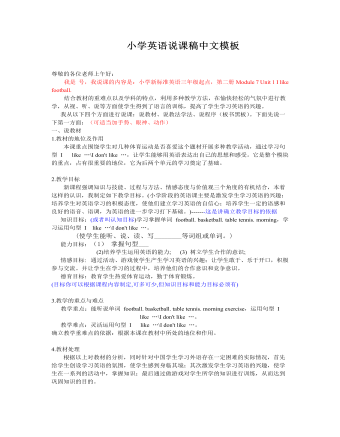
小学英语说课稿中文模板
一、说教材1.教材的地位及作用 本课重点围绕学生对几种体育运动是否喜爱这个题材开展多种教学活动,通过学习句型 I like …\I don't like …,让学生能够用英语表达出自己的思想和感受。它是整个模块的重点,占有很重要的地位,它为后两个单元的学习奠定了基础。 2.教学目标 新课程强调知识与技能、过程与方法、情感态度与价值观三个角度的有机结合,本着这样的认识,我制定如下教学目标。(小学阶段的英语课主要是激发学生学习英语的兴趣;培养学生对英语学习的积极态度,使他们建立学习英语的自信心;培养学生一定的语感和良好的语音、语调,为英语的进一步学习打下基础。)-------这是讲确立教学目标的依据 知识目标:(或者叫认知目标)学习掌握单词 football. basketball. tabletennis. morning,学 习运用句型 I like …\I don't like …。

小学美术人教版六年级下册《第9课图文并茂3》教学设计说课稿
2重点难点教学重点第一课时:了解绘画故事的表现特点,感受真、善、美。第二课时:绘画自编故事的创作特点及步骤。教学难点第一课时:选材、构思设计。第二课时:构图与绘制3教学过程3.1 第一课时教学活动活动1【导入】“连连看” 教师提供数张图片和几句话(或几段文字),请学生根据文字找到相应的图画将它们连起来,并找出先后顺序将故事讲完整。教师小结,出示课题《图文并茂》。设计意图:以游戏的形式“连一连”,激发学生的好奇心和兴趣,以饱满的热情投入学习内容——图文并茂。
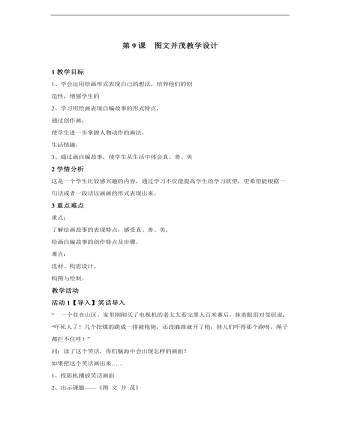
小学美术人教版六年级下册《第9课图文并茂2》教学设计说课稿
2学情分析这是一个学生比较感兴趣的内容,通过学习不仅能提高学生的学习欲望,更希望能根据一句话或者一段话以画画的形式表现出来。3重点难点重点:了解绘画故事的表现特点,感受真、善、美。绘画自编故事的创作特点及步骤。难点:选材、构思设计、构图与绘制。
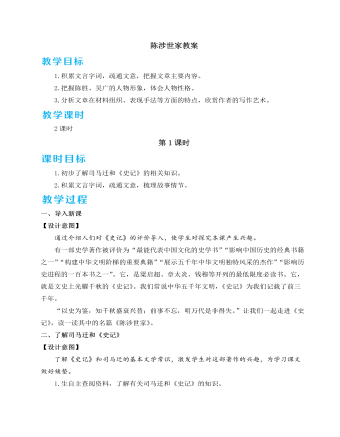
人教部编版语文九年级下册陈涉世家教案
1.王侯是一个地区的实际统治者,世代保有其国,对全国政局有一定的影响,故其传记称为“世家”。陈涉并非王侯,司马迁为什么把他归入“世家”?《史记》中人物传记分为三类,“本纪”记帝王,“世家”记王侯,“列传”记人臣,但这只是一个大略的划分,对于某些历史人物,作者有他特殊的考虑。陈涉就是一个特例。他出身低微,起义后虽自立为王,但为时仅六个月。之所以列入“世家”,是因为在秦王朝的严酷统治下首先发难,的确是非常之功。司马迁在这篇传记的最后写道:“陈胜虽已死,其所置遣侯王将相卒亡秦,由涉首事也。”可见司马迁看重的是功业,而不以成败论英雄。类似的例子有项羽,他并未统一称帝,但作者高度评价了他在反秦斗争中的领导作用,把他列入“本纪”。2.本文是长篇节选,在结构上具有怎样的特点?
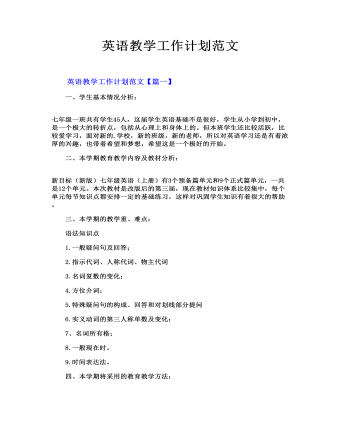
英语教学工作计划范文
1.用英语教英语(Teach English inEnglish); 英语毕竟是一门语言,训练的是学生的听、说、读、写、译的综合能力,在教学的过程中需要对学生的听、说、读、写、译的能力进行很多的训练,这就要求我们用英语来教英语,在课堂上对学生进行各种能力的训练。
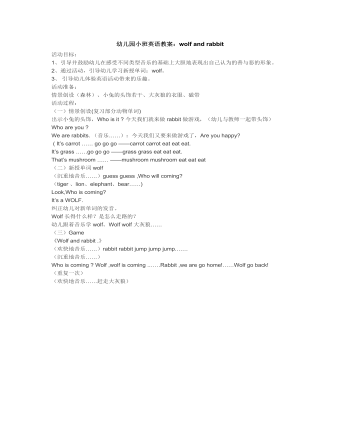
幼儿园小班英语教案:wolf and rabbit
2、通过活动,引导幼儿学习新授单词:wolf。 3、 引导幼儿体验英语活动带来的乐趣。 活动准备: 情景创设(森林)、小兔的头饰若干、大灰狼的衣服、磁带 活动过程: (一)情景创设(复习部分动物单词) 出示小兔的头饰,Who is it ? 今天我们就来做rabbit做游戏,(幼儿与教师一起带头饰) Who are you ? We are rabbits. (音乐……):今天我们又要来做游戏了,Are you happy? ( It’s carrot …… go go go ——carrot carrot eat eat eat.It’s grass ……go go go ——grass grass eat eat eat.That’s mushroom …… ——mushroom mushroom eat eat eat(
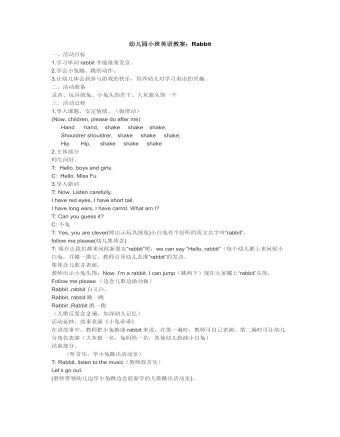
幼儿园小班英语教案:Rabbit
二、活动准备 录音、玩具绒兔、小兔头饰若干、大灰狼头饰一个 三、活动过程 1.导入课题,安定情绪。(做律动) (Now, children, please do after me) Hand hand, shake shake shake; Shouldrer shouldrer, shake shake shake; Hip Hip, shake shake shake2.主体部分 师生问好。 T: Hello, boys and girls. C: Hello, Miss Fu. 3.导入新词 T: Now, Listen carefully. I have red eyes, I have short tail, I have long ears, I have carrot. What am I?T: Can you guess it? C: 小兔 T: Yes, you are clever(师出示玩具绒兔)小白兔有个好听的英文名字叫“rabbit”,follow me please(幼儿集体念)
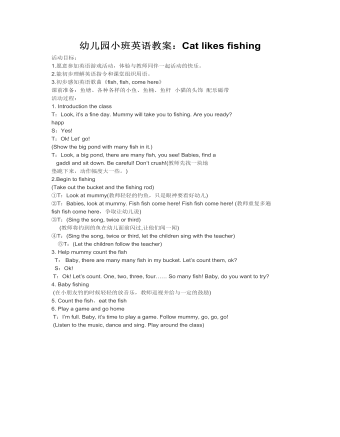
幼儿园小班英语教案:Cat likes fishing
3.初步感知英语歌曲《fish, fish, come here》 课前准备:鱼塘、各种各样的小鱼、鱼桶、鱼杆 小猫的头饰 配乐磁带 活动过程: 1. Introduction the class T:Look, it’s a fine day. Mummy will take you to fishing. Are you ready?happ S:Yes! T:Ok! Let’ go!(Show the big pond with many fish in it.)T:Look, a big pond, there are many fish, you see! Babies, find a gaddi and sit down. Be careful! Don’t crush!(教师先找一块地 垫跪下来,动作幅度大一些。)
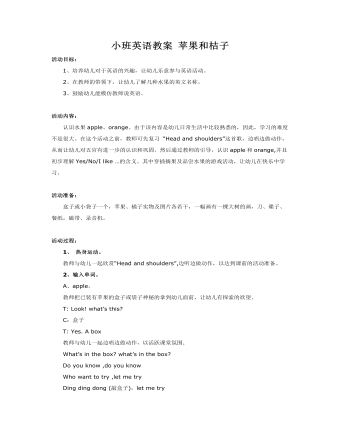
小班英语教案 苹果和桔子
2、在教师的带领下,让幼儿了解几种水果的英文名称。3、鼓励幼儿能模仿教师说英语。 活动内容: 认识水果apple、orange。由于该内容是幼儿日常生活中比较熟悉的,因此,学习的难度不是很大。在这个活动之前,教师可先复习 “Head andshoulders”这首歌,边唱边做动作,从而让幼儿对五官有进一步的认识和巩固。然后通过教师的引导,认识apple和orange,并且初步理解Yes/No/I like …的含义。其中穿插摘果及品尝水果的游戏活动,让幼儿在快乐中学习。 活动准备: 盒子或小袋子一个,苹果、橘子实物及图片各若干,一幅画有一棵大树的画,刀、碟子、餐纸,磁带、录音机。活动过程:1、热身运动。 教师与幼儿一起欣赏“Head andshoulders”,边听边做动作,以达到课前的活动准备。
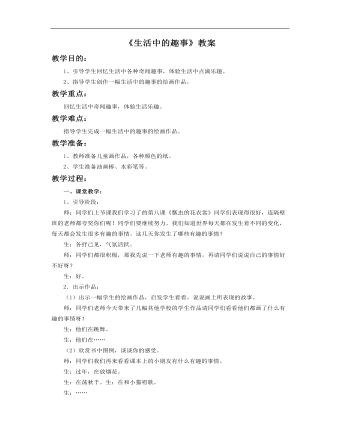
小学美术人教版一年级下册《第9课生活中的趣事》教案说课稿
一、课堂教学:1、引导阶段:师:同学们上节课我们学习了的第八课《瓢虫的花衣裳》同学们表现得很好,连隔壁班的老师都夸奖你们呢!同学们要继续努力。我们知道世界每天都在发生着不同的变化,每天都会发生很多有趣的事情。这几天你发生了哪些有趣的事情?生:各抒己见,气氛活跃。师:同学们都很积极,那我先说一下老师有趣的事情,再请同学们说说自己的事情好不好呀?
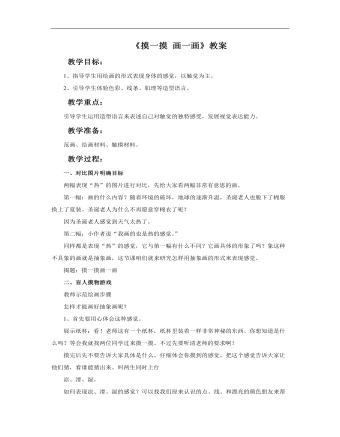
小学美术人教版一年级下册《第6课摸一摸画一画》教案说课稿
一、对比图片明确目标两幅表现“热”的图片进行对比,先给大家看两幅非常有意思的画。第一幅:画的什么内容?随着环境的破坏,地球的逐渐升温,圣诞老人也脱下了棉服换上了夏装。圣诞老人为什么不再愿意穿棉衣了呢?因为圣诞老人感觉到天气太热了。第二幅:小作者说“我画的也是热的感觉。”同样都是表现“热”的感觉,它与第一幅有什么不同?它画具体的形象了吗?象这种不具象的画就是抽象画,这节课咱们就来研究怎样用抽象画的形式来表现感觉。揭题:摸一摸画一画
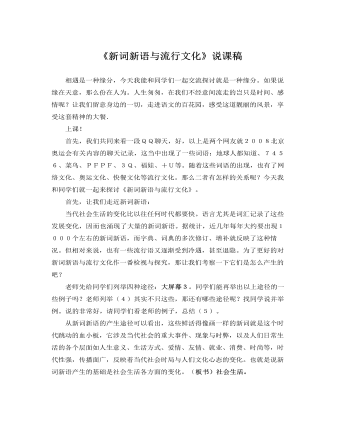
人教版高中语文必修1《新词新语与流行文化》说课稿
当代社会生活的变化比以往任何时代都要快。语言尤其是词汇记录了这些发展变化,因而也涌现了大量的新词新语。据统计,近几年每年大约要出现1000个左右的新词新语,而字典、词典的多次修订、增补就反映了这种情况。但相对来说,也有一些流行语又逐渐受到冷遇,甚至退隐。为了更好的对新词新语与流行文化作一番检视与探究,那让我们考察一下它们是怎么产生的吧?老师先给同学们列举四种途径:大屏幕3。同学们能再举出以上途径的一些例子吗?老师列举(4)其实不只这些,那还有哪些途径呢?找同学说并举例。说的非常好,请同学们看老师的例子,总结(5)。从新词新语的产生途径可以看出,这些鲜活得像画一样的新词就是这个时代跳动的血小板,它涉及当代社会的重大事件、现象与时弊,以及人们日常生活的各个层面如人生意义、生活方式、爱情、友情、就业、消费、时尚等,时代性强,传播面广,反映着当代社会时局与人们文化心态的变化。


